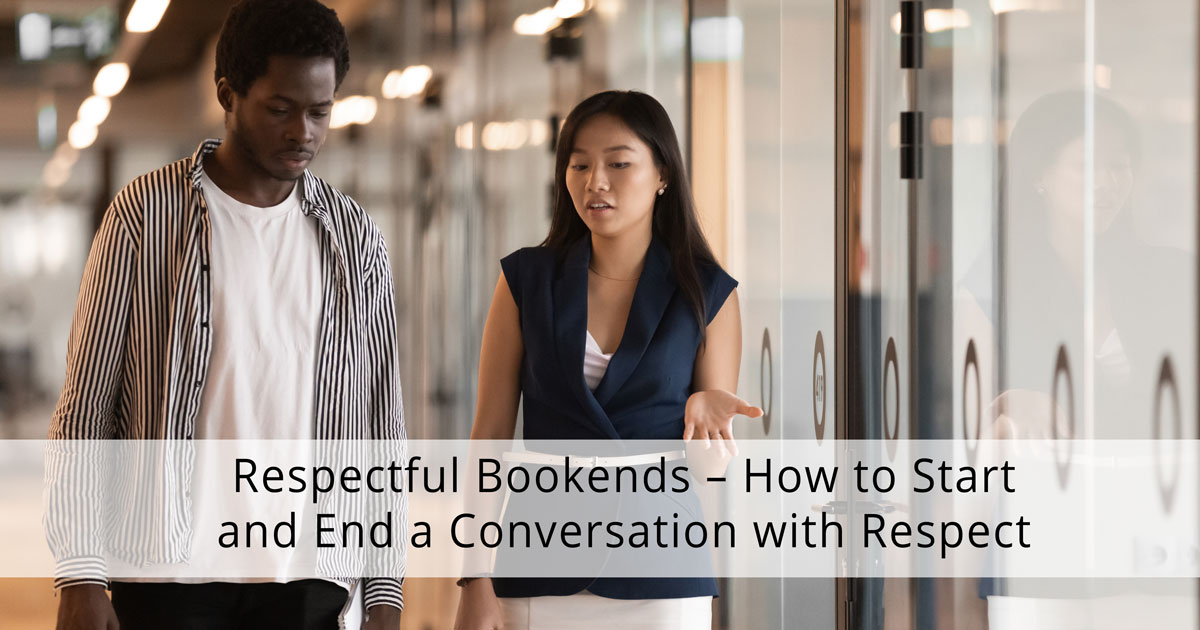Resources > Blog > Respectful Bookends – How to Start and End a Conversation with Respect

I often call formal workplace investigations my “land of missed conversations” because many of the complaints are triggered by conversations that didn’t happen. Individuals have “stories in their heads” that are based on insufficient information, misinformation or inaccurate second-hand information. Left unchecked, the internal narratives build and fester leading to interpersonal conflict and dysfunction and ultimately to a formal complaint.
However, another common and equally avoidable trigger for these investigations involves conversations that go sideways. This happens where one person attempts to address an issue or concern directly which then backfires, leading to an escalation and further polarization of the situation.
Many workshops on conflict resolution (including mine) outline how to properly communicate through conflict in a way that makes any situation better, not worse. However, many workshops neglect to mention that respectful conversations begin well before they start – and continue well after they end. The respectful set up of conversations – and the respectful follow through after they’re over – are what I call “the bookends of respect”.
Let’s look at both in turn.
Bookend One: Setting Up for Success
In order to significantly increase the odds of your conversation being successful, it is important to set it up in a respectful manner. This includes taking the following steps (and always, in a non-threatening way using a collegial tone):
- Let the other person know – briefly – what it is you want to talk about;
- Find a mutually convenient time – within the next few days – to talk about it;
- Find a mutually convenient and confidential space in which to have the discussion; and
- If you are bringing someone with you, let the other person know and invite them to do the same.
If someone denies the “need” to have the conversation, respect their view and don’t try to argue them out of it, but clarify that you still want to have one based on your own experience.
If they continue to resist engaging with you, don’t get angry or “make it personal” – simply indicate that you will reach out to others for support in facilitating the conversation. Sometimes, that’s all that is necessary to encourage participation but even when it’s not, it avoids the other person being blindsided when a supervisor or Human Resources subsequently reaches out to them.
While this is happening, do not announce to others your intention to have this conversation or what you plan to say. Including others in matters that don’t involve them often causes them to feel “caught in the middle”. Even where they don’t feel that way, it is often viewed as disrespectful to gossip about such confidential conversations unless those with whom you speak have a need to know about your intentions.
Bookend Two: Ending with Integrity
Even where conversations are set up for success, and appear to have gone relatively smoothly, they may end up going sideways, after the individuals have left the room.
In order to prevent this from happening, it is important to take the following steps:
- Keep the contents of and disclosures made during the conversation private unless disclosure is necessary for work-related purposes or to fulfil any operational commitments you might have made during the discussion. Many times, individuals disclose private matters or apologize and accept responsibility over certain interpersonal dynamics. These disclosures are incredibly helpful in reaching resolution during the conversation – but inappropriate disclosure of them to others after the fact will sabotage the progress that was made and may well constitute a separate complaint of disrespect.
- Follow through on commitments you made during the conversation. If you said you’d provide further information, do so. If you promised to make a change in practice, demonstrate that. Walk the talk of the promises made.
- Do not retaliate after the conversation. Often individuals “pretend” to be respectful during the conversation but then punish the other person afterwards, through shunning, lack of responsiveness to requests for help and other forms of disrespectful conduct. Individuals have a right to be treated with respect at all times, even when others disagree with aspects of the conversations including accusations that may have been made. If someone is upset about a conversation after that conversation, the answer lies in having a follow-up discussion. The answer is not to retaliate.
There is no question that what is said during a conversation – and how it is said – must be respectful in tone and content. However, without considering the bookends of respect, the most respectful of conversations can go sideways, leading to formal complaints and boardrooms with binders. That’s something to avoid, wherever possible.
Order your copy of “Walking On Eggshells?”
LEARN MORE ABOUT:
